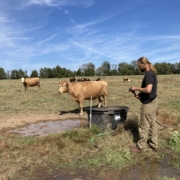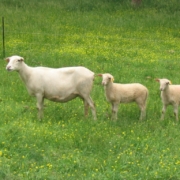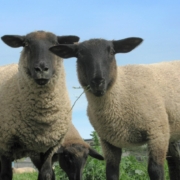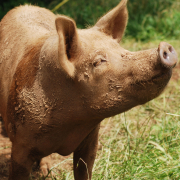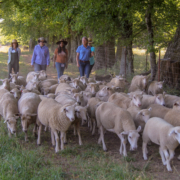New Resources to Demystify Regenerative Grazing and Soil Health
 Print This Post
Print This Post
By Nina Prater, NCAT Sustainable Agriculture Specialist
The terms regenerative grazing and soil health have started to seem almost ubiquitous in the world of agriculture. This is heartening for me as a soil specialist with NCAT, where I consider it part of my job to help producers understand and take care of their soils, as it is key to their long-term success as farmers and ranchers.
As a farmer, the evolution of language around grazing has been interesting to watch over the past 15 years. I first moved to Arkansas and became part of a livestock farming family in 2007, and I’d never heard of regenerative grazing. My husband and I, the third generation of the farm family, did a lot of reading when we returned to the farm and learned about continuous vs. rotational grazing, management-intensive grazing, mob grazing… on and on. We were awash with terms from different schools of thought about grazing management. Instead of getting hung up on the language, though, we just tried to implement a grazing management practice that improved pasture and soil health. When I finally did hear the term regenerative several years ago, it resonated immediately as what we were trying to do. To me, regenerative means restoring health to the whole farm system. I find it to be such an empowering term because it carries with it the implication that soil health can be restored. You’re not just stuck with what you’ve got right now. You can improve the health of your soil through a variety of practices, and in doing so, increase the productivity and profitability of your farm. Isn’t that exciting?!
Thanks to funding from a Southern SARE grant, I have been working to demystify the terms regenerative grazing and soil health for a variety of folks in Alabama, Mississippi, Arkansas, and Texas (and via virtual platforms for people in other places). I think if farmers, ranchers, extension staff, NRCS staff, and other agriculture professionals understand these terms and how to work towards those goals we could see improvement to our agricultural landscapes across the country.
On the ATTRA website, we recently shared two resources that are a part of this project. The first is a recorded virtual workshop that covers soil health, regenerative grazing, and farmer support. It includes presentations by two Arkansas graziers, Jeremy Prater and Rick Crunkleton, who are regenerating their land through their grazing management practices. The second resource is a regenerative grazing presentation, by NCAT’s Regenerative Grazing Specialist Justin Morris, as a stand-alone for folks who want to learn more about that concept specifically.
And in case you missed it, last year we hosted a virtual workshop with Dr. Allen Williams of Understanding Ag, LLC on this topic as well. He is an excellent teacher and explores these topics in great depth, and this workshop would complement the two listed above very well.
I hope you will check these recordings out and start your journey on the path of soil health and regenerative agriculture. And please share with anyone you think would benefit from learning more about these topics!
Related ATTRA Resources:
This blog is produced by the National Center for Appropriate Technology through the ATTRA Sustainable Agriculture program, under a cooperative agreement with USDA Rural Development. This blog was also made possible in part by funding from the Southern Sustainable Agriculture Research & Education (SSARE) Professional Development Program. ATTRA.NCAT.ORG.

